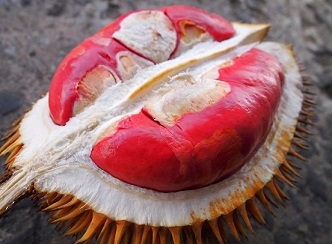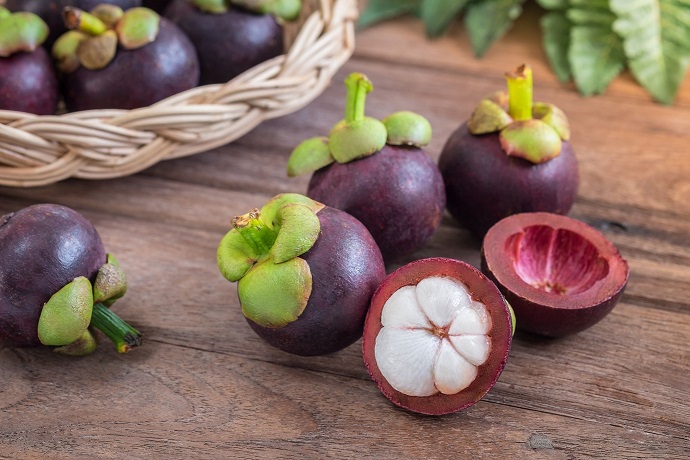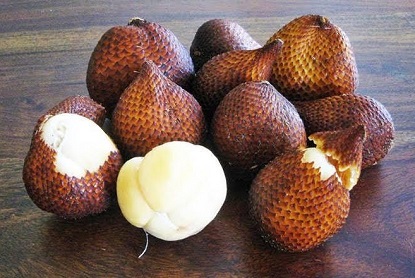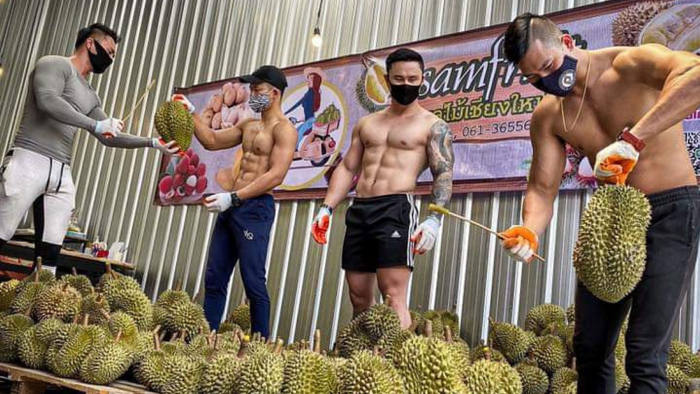Everything To Sea Staff Picks: Indonesia’s Exotic Fruits
“Blessed be the fruit” (we’ll send you five pictures of hot guys with fruit, if you can guess this reference. Just leave a comment in the section below). Surely you know about eggplants????, bananas????, and peaches????. In this blog post, Everything To Sea staff share their favorite fruits. For this list, we’re focusing on fruits that are native Indonesian and considered exotic to this Southeast Asian country.
Our Content Editor Darren admitted that there are so many exotic fruits in Indonesia that he could not just pick one.
“It’s like we’ll have no shortage of fruits to try… or to put into our cocktails,” he said cheekily.
1. Durian
We can’t make a blog post about Indonesian fruit without mentioning this sexy beast. No, not one of those guys in the photo above, but the fruit that they’re selling: Durian, The King of Fruit.
This fruit is native to Borneo and Sumatra, although nowadays it’s also common in Thailand and Malaysia. The fruit has a strong, distinctive smell that can literally be smelled when you’re fifteen minutes away from it! When you travel to Southeast Asian countries, you’ll see some establishments such as hotels, which forbid people from bringing durians into their premises. So don’t worry… the fruit won’t be accompanying any flights to Indonesia.
Some people consider this fruit a delicacy, though. Just ask our amazing tech guy, Hans.
“The smell of durian can be very intimidating and intense, but that’s what I love about durian. You can even know its presence from another room. It tastes sweet and… sometimes if you get lucky, it can taste alcohol-y, like rum!” he said of the exotic fruit.
Our Support Specialist Roni particularly loves Red Durian, which is a unique variety only found in Banyuwangi, East Java. This type of durian is smaller and much sweeter than other durians. The texture is also a little bit more solid.
“What I like is that it’s creamy, with a smooth flesh. It has a distinctive flavor and somehow the red color makes it more appealing to me,” said Roni.

TRIVIA: We found out that carnivorous tigers eat durians sometimes in the wild.

2. Mangosteen

It’s been said that Queen Victoria once offered 100 pound sterling to anyone who could bring her mangosteens. Whether or not this legend is true, the story has become so popular that mangosteen been given the title as ‘The Queen of Fruit’. Yep, paired with durian, ‘The King’. Even the Chinese suggest balancing eating durian, which is considered ‘heaty’, with mangosteen, which is regarded as having more ‘cooling’ effects.
This fruit is native to Southeast Asia, especially Indonesia. The flesh of mangosteen fruit is sweet, juicy, and rich with fiber. Mangosteen also has some healing effects and is famous as an antioxidant. It is often used as an ingredient for traditional medicines.
Our co-founder Max considers mangosteen one of the most amazing fruits in Indonesia.
“The hard and brown-reddish shell reveals a white flesh. When you open it you’ll find five kidney-shaped white pieces. The larger ones have stones inside of them,” said Max.
“You basically can suck the sweet soft flesh from the stone. But the best parts are the smaller ones, without the stone inside. They are like little gummy bears. So delicious…,” said Max, longingly.
3. Rambutan

This fruit originated from the Indonesia-Malaysia region. In the Indonesian language, the word rambut literally means hair, while ‘-an’ is a noun-building suffix. So the name rambutan means hairy in English. Hairy fruit… sounds interesting, right?
Rambutan is sweet and juicy and can be mentally addictive. They’re also co-founder Dave’s favorite fruit! Of the unique, hairy fruit, he appreciates both the name and the taste.
“I really love the name… it’s basically “hairy” balls. And the unique texture – soft and squishy… and the taste – so sweet! It’s cool that it’s almost unexportable. It doesn’t travel well, so you have to be in a place like this to have it. On top of everything else, I definitely love the way it looks,” he said.
Eddie, our Communications Specialist, also loves the fruit:
“I sometimes joke to my friends that if a man proposes to me with a truck full of rambutan, I’ll marry him immediately,” he said, laughing.

4. Banana

There are probably over 1,000 varieties of bananas in the world. Not just those lengthy, curvy, yellow ones that are so commonly seen. Much like our travelers who join our cruises… bananas have many lengths, diameters, and… tastes!
Indonesia is known as one of the biggest producers of bananas in the world. A lot of locals consume this fruit. Here there are around 230 different cultivations of bananas.
Indonesians also prepare bananas in other ways – one of them being kolak, which is a local dessert with ingredients that include palm sugar, coconut milk, and pandanus leaf.
Roni loves this fruit in particular.
“This fruit… I have always had it ever since I was a kid. I love the smell, the flavor and its smooth texture,” said Roni.
5. Salak

Known by English speakers as snakefruit due to its brown scaly skin, salak is native to Java and Sumatra in Indonesia.
The size of the salak is around half of your fist. The pulp is edible and tastes sweet! To open it, pinch the tip so you can start tearing the skin away. The lobes look like large, peeled garlic cloves, and each one contains a large brown seed.
Eddie likes salak because they’re crunchy and sweet…
“Thus fruit reminds me of my childhood. I remember my mom and I ate this together when I was young,” he said.
6. Indonesian Pomelo
Locally known as Jeruk Bali or literally “Balinese Orange”, this fruit resembles larger oranges. There are two kinds of Indonesian pomelo, including the sweet kind with white flesh, and the sour kind with pinkish flesh.
“I love how the tiny segments filled with delicious juice pop in your mouth when biting on them,” said Max.

Although these are the staff’s favorite picks, there are so many more fruits in Indonesia that are unique to the region. From Jambu Air (water rose apple) to Lychee, Coconut to Jackfruit, Longan to Guava, Avocado, Sweet Mango, and Starfruit, one thing’s for sure – you won’t be bored eating fruits here. And we didn’t even get to talk about Chilis! Yep, they’re a fruit, too. The stuff growing in this sprawling island-nation continues to amaze all of us living here.


“Blessed Be the Fruit”: The standard greeting amongst Gilead residents. The traditional reply is “May the Lord open.” … They feature no text (much like the product labels for which they can be exchanged), because in Gilead, women are forbidden from reading.
Great job, Damon! The Handmaid’s Tale, written by Margaret Atwood and now a TV series on Hulu, is definitely one of the most dramatic and thrilling work of fiction of all time. 🙂 Your ‘reward’, Damon, is on its way!
Aww… shoot! I knew the answer and when I got down here to the comments I found that Damon had already answered you. Ahh well. Thanks for the lessons on fruits of the islands! I can’t wait to try red durian, mangosteen, rambutan, white pomelo and jambu air.
Haha. It happens! You’re very welcome and we can’t wait for you to try those fruits you mentioned. We can have an Indonesian fruit feast on one of our cruises! – Eddie
Thanks for the info on the island fruits! Other than bananas, I have never heard of the others.
Sam
You’re very welcome! We can have a feast together when you join our trip! – Eddie
Deuteronomy 28:4 Blessed shall be the fruit of your body, the produce of your ground,…….